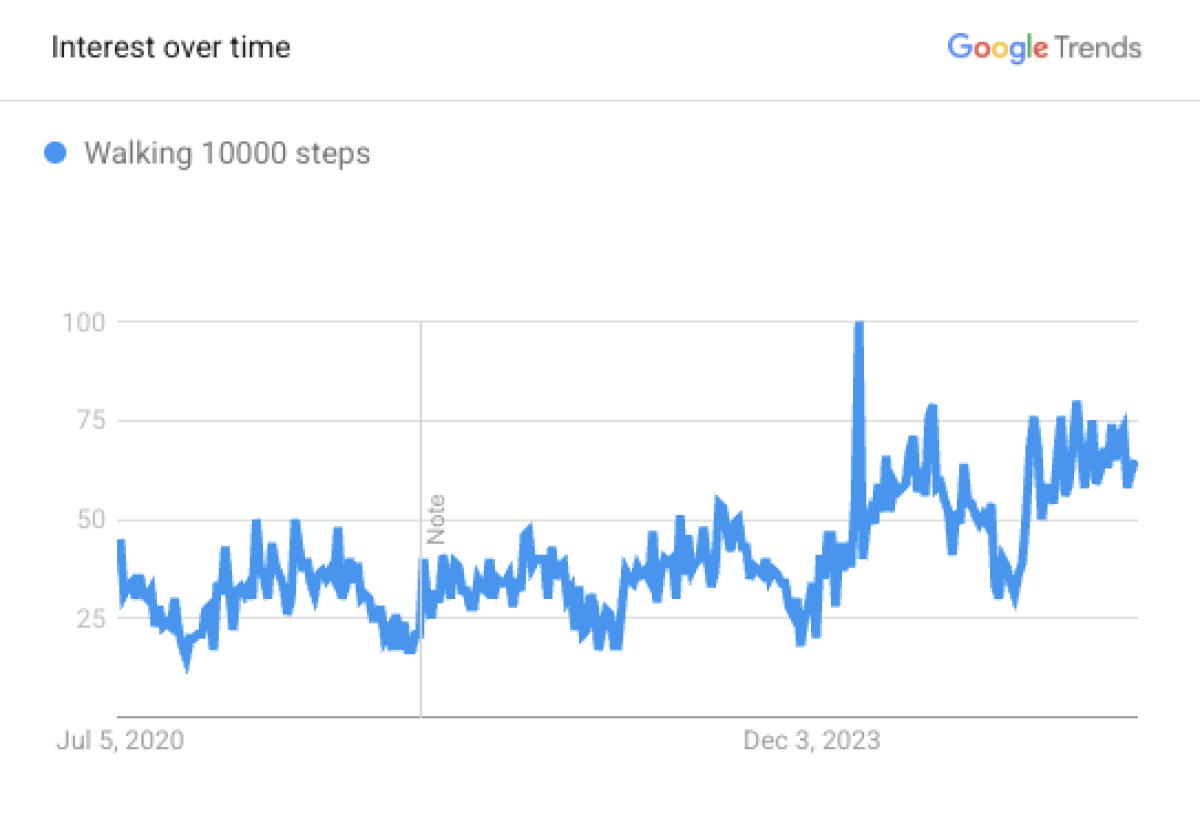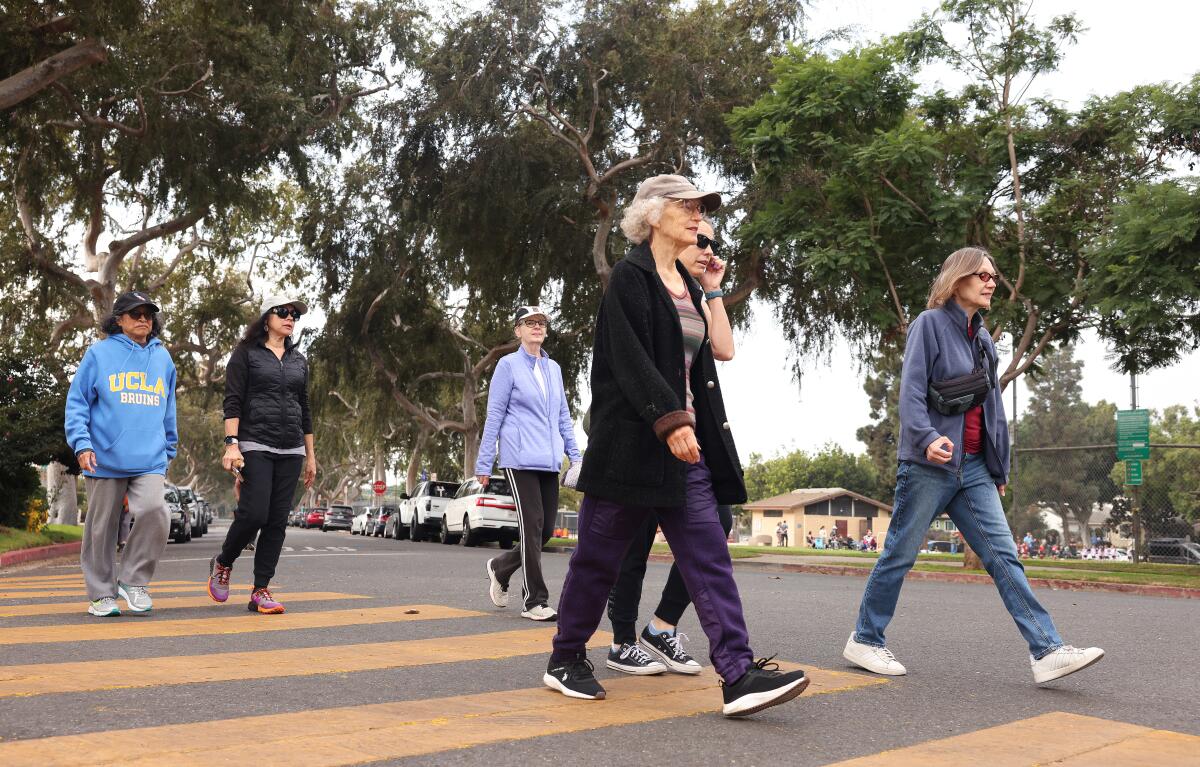The magic number appears in smart watches, physical conditioning applications and office passage challenges. For many, reaching 10,000 steps in one day has become a marker of good health, an objective that causes hiking after dinner, turned at lunch time around the block and a reason to park a little further.
While the objective is widely adopted by doctors and their patients, their origins are less scientific than some can expect.
“The idea behind the 10,000 steps was actually a marketing campaign for a company in Japan that developed a pedometer,” said David Raichlen, a professor of biological sciences and anthropology at the USC.
The idea of walking 10,000 steps per day gained popularity in Japan in the 1960s, when a company introduced a pomometer called Manpo-Kei, a name that translates into “10,000 step steps.” Duning around the time of the 1964 Tokyo Olympic Games, the product gave people a numerical goal and helped sell pedometer.
“It was a bit bright,” Raichlen said. “Is it arbitrary? Yes.”
A couple takes advantage of the pleasant climate to walk their dog in the historical district of the Venice Canal in Venice Beach.
(Allen J. Schaben / Los Angeles Times)
The researchers say that even if the number was not based on evidence at that time, he realized for a reason, and may have landed near a significant reference point.
“It turns out that, strangely, they were probably not so far, although they had none of the epidemiological data to support them at that time,” Raichlen said.
In the years since the objective of 10,000 steps gained attraction, researchers have tried to identify how many daily steps are really linked to better health results. Some studies show that the benefits, such as the reduced risk of cardiovascular disease, begin around 2,500 to 3,000 steps per day. Others suggest that a health -related benefit plateau begins about 7,500 steps, Raichlen said.
Even so, many public health messages continue to promote the five -digit brand and physical conditioning trackers, including fitbits and other intelligent devices, often establish 10,000 steps such as the predetermined daily objective.
Dr. Gregg C. Fonow, interim head of cardiology at UCLA, said that steps counts are a practical and easy to understand to communicate physical activity guidelines with patients. Often recommends 10,000 steps and does not see the number as random.
“Transmitting the Steps count is one of the ways of quantifying, in an easy and understandable way, a traceable and processable form of communicating what a good level of physical activity would be for them,” said Fonarow.

Searches for “walking 10000 steps” have increased in the last five years.
(Google Trends)
He said that 10,000 steps are equivalent to approximately five miles of walking and approximately 150 minutes of moderate to intensive activity, in line with the existing guidelines for the weekly exercise.
Even so, Fonarow recognizes that the research results vary. He cites a study that found that risk reduction stabilized around 7,500 steps for older women, while other studies have found that the benefit continues through 10,000 steps or more. “Walking is a fantastic way of exercise,” said Fonarow. “It improves blood pressure, supports brain health, reduces insulin resistance and helps strengthen blood vessels.”
Raichlen said that he generally avoids prescribing specific thresholds. While 10,000 steps can be a useful objective for some, he said, it is not a requirement for good health.
“A little is better than anything, and then a little more is better than that,” Raichlen said.
However, the type of walking is important. Researchers have found that cadence, how many steps a person takes per minute, can influence the impact of physical activity. A fast walk offers greater cardiovascular benefit than a slower pace even with the same total strokes.

Wes Brobough, on the left, and Tucker O'Neill get some steps on their 41 mile walk through Los Angeles. In 2023, they went from Pasadena to Santa Monica.
(Irfan Khan / Los Angeles Times)
“You don't have to run,” Raichlen said. “But more intensity is generally better.”
What is not clear, he said, is if there is an upper limit where the benefits begin to decrease, or if more steps always produce more return.
He said that walking is more generally linked to the lower risk of several chronic conditions, including diabetes, dementia and cardiovascular disease, but risk reduction is poured after a certain point.
“The result of the health that interests you, be it heart disease, diabetes, dementia, different steps are recommended,” he added.
Raichlen also pointed out that the effectiveness of a given steps count may differ according to age and that most existing studies depend on wrist accelerated accelerometers, which may vary in precision.
“You can use multiple methods and end with multiple counts of different steps of exactly the same person,” Raichlen said, adding that his sister -in -law and his son tracked their steps on a recent trip to Disneyland using different devices, one with one phone, the other with an Apple Watch, and came out with very different totals.
That variation, he said, reinforces the importance of using steps counts such as a guide instead of a rigid rule.
“The best thing people can do is be their own study,” Raichlen said. “Look what you are doing today and try to do more tomorrow.”
Fonow said it often encourages patients to build activity gradually. For those who are largely sedentary, trying to walk 10,000 steps the first day may not be practical. “We really need to customize these recommendations,” he said, adding that some people can choose to add resistance, such as a weighted backpack, for additional benefits, but it is not necessary to improve health.

The Culver City Everwalk Walking Club, one of the several groups on foot in Los Angeles, usually meets the first Saturday of each month.
(Christina House / Los Angeles Times)
Dr. Parveen Garg of Keck Medicine of USC also sees patients seeking to meet the steps. While the extension of the activity throughout the week is ideal, he said that it is fine if some days are more active than others. For patients with limited time or energy, walking more on weekends or during longer breaks can offer significant benefits.
Garg said he reminds patients to walk is beneficial even at lower levels. Multiple studies show that the risk of cardiovascular disease and premature death decrease in a meditable way from about 2,500 steps per day, he said.
While the extension of the activity throughout the week is ideal, he said that it is fine if some days are more active than others. For patients with limited time or energy, walking more on weekends or during longer breaks can offer significant benefits. Like other experts, Garg emphasizes that the benefits of movement do not start in 10,000 steps, they can start much earlier.
“As humans, we like goals,” Garg said. “We like to feel that we have achieved something. We like to mark the boxes … it gives people a goal to achieve. In that aspect, it is really great, as long as it does not discourage people.”
It encourages their patients to prioritize aerobic activity, a movement that obtains the heart rate, even if it is done in short bursts or mixes with the daily routines.
Whether a person walks 2,000 steps or 10,000, local experts agree that the key is consistency, and increasing the activity over time can be beneficial.
“Keep moving,” Raichlen said.












